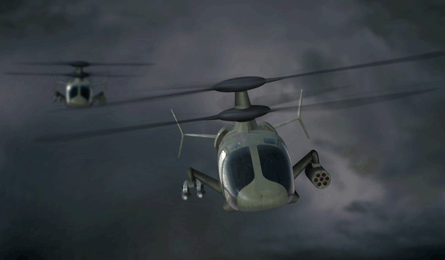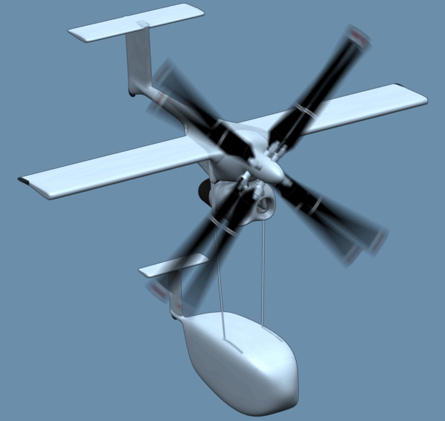In early December, in an Orlando venue packed with US military brass and rotorcraft industry leaders, inventor Doug Baldwin, of Baldwin Technology, presented his case for the Mono Tiltrotor (MTR). "I'm going to make a lot of assertions," said Baldwin, who has been developing the concept for a decade. "I welcome you to challenge any of the assertions that I make."
After the brief, Baldwin recalls, his challenge was accepted. Abe Karem, who invented what became the Predator and Hummingbird unmanned aircraft systems, rose to question the MTR's power source: two Rolls-Royce AE1107C engines. This seemed excessive to Karem, who "did point out that this MTR aircraft would be over-powered with two AE1107Cs", confirms Karem Aircraft's Dan Platt. It is a point that Baldwin concedes. "Karem was right," he said recently.
 |
|---|
© SikorskySikorsky is applying its X2 technology to the S-97 Raider programme |
However, Karem's question raised what Baldwin considers a basic problem in the rotorcraft industry. Even as a new wave of high-speed rotorcraft seek to reach experimental phase, the industry has developed only two tilting engines: the AE1107C and the Light Helicopter Turbine Engine T800. Karem, however, points out a third tilting engine exists, with the Pratt & Whitney Canada PT6C-67A powering the BA609, conceived as a joint venture between AgustaWestland and Bell Helicopter.
UNCHANGED SINCE VIETNAM
To some observers, it was a remarkable exchange in what was already an unusual meeting. Perhaps reflecting the broader aviation industry, rotorcraft companies tend to keep a close hold on information about future concepts. "I think it's historical, and it may even go all the way back to the Wright Brothers and [Glenn] Curtiss," Baldwin says. "What most people tend to do is work in private then come out and reveal bits and pieces."
That may have to change for the US helicopter industry to break out of a 30-year dry spell. While the Bell Boeing joint venture has fielded the V-22 tiltrotor, the forward speed of most military and commercial helicopter designs has not changed since the Vietnam war.
A desire to break that mould prompted the Orlando event which hosted Baldwin's presentation. While the exchange occurred during a meeting of the Office of the Secretary of Defense's (OSD) future vertical lift group, the event also hosted a meeting of the new vertical lift consortium (VLC), a group that has galvanised and split opinions in the rotorcraft industry. The VLC's approach is to foster dialogue and collaboration such as occurred between Baldwin and Karem. "That discussion in public, and [Baldwin] identifying the problem, caused all sorts of discussion from a number of people in that room," says Steve Mundt, the VLC's chairman and also vice-president of business development for EADS North America.
After the VLC formed about a year ago, in response to pressure from the OSD, the industry rapidly signed up to participate. "There's 97 members in the consortium," Mundt says. "That's more members than AHS [the American Helicopter Society] has today. It shows there's a strong outpouring that we're interested in this." Acknowledging the failures of several recent helicopter procurements, the OSD is developing a roadmap for meeting the future vertical lift needs of each of the services. The roadmap is intended to align the rotorcraft's internal research and development spending with the government's long-term needs.
"The industry at large has $1 billion in IR&D," Mundt says. "If the government were to tell any company where to spend that money, there would be all sorts of legal implications. So how do we leverage the billion in industry? You have to have an established roadmap with requirements and timelines that you want this technology."
Once those requirements are defined, the VLC is expected to self-form teams to bid for technology development contracts, with the government contributing seed funding.
"There is an OTA [other transaction agreement] signed between the government and the consortium. That OTA is like an [indefinite delivery/indefinite quantity] contract," Mundt says. "The government can come and put out a white paper or requirement that says, 'I'm looking for Technology X' and it comes to the consortium and it's passed out to all the members." It is not required under an OTA to select a non-traditional supplier but companies are rewarded for making those arrangements. "If I take a non-traditional and team with them, then I get a break and the government provides more resources and the government helps that team." The objective is to give rotorcraft primes an incentive to work with smaller, more innovative firms, such as Piasecki and Karem, Mundt says. "We've got to find a better way to do this and we need a teaming between the industry and the department," he asserts. "Then we have a much better chance of success."
NON-TRADITIONAL SUPPLIERS
The OSD has modelled the VLC on similar consortia formed in the munitions and robotics industries. Neither matches the scale and complexity of the rotorcraft industrial base.
Opinions about the wisdom of the VLC approach are mixed even among members such as Karem Aircraft, one of the non-traditional suppliers the VLC is designed to benefit. The company offered less than a full endorsement of the strategy when asked for comment.
"A consortium like the VLC will have value only if empowered and fair for all members," says Platt. "We believe the current state of vertical lift technology can only be truly advanced through fair and competitive processes focused on rapid, large-scale prototyping of advanced configurations." Another VLC member, Sikorsky, is even more sceptical. Steve Weiner, Sikorsky's director of engineering sciences, insists Sikorsky has already been innovating in rotorcraft without the help of a consortium.
 |
|---|
© Bladwin TechnologyBaldwin Technology's MTR |
"If you look at why the VLC was formed, it was OSD striving to get industry involved and have a teaming effect to get more R&D dollars - to have a consolidation of R&D for rotorcraft," he says. "Well, look at who's investing in rotorcraft across the industry today? Sikorsky. What are our competitors doing? You go evaluate that for yourself. "When we go to the VLC meetings and they stand up and say nobody is investing in technology, except Sikorsky. Nobody's doing anything to advance rotorcraft technology, except Sikorsky. Our competitors are out there talking about and trying to encourage DoD investment. We, on the other hand, have a leadership that not only has a vision but has the courage to put their money where their mouth is and invest our money in the future, and try to drive that rotorcraft technology. So we are a part of the VLC but we're moving out on our own not waiting for the government to lend a helping hand in developing new technologies."
Sikorsky has succeeded in demonstrating the X2, a coaxial, compound rotor capable of flying at 270kt (500km/h). It followed that by launching the S-97 Raider programme, building two prototypes to demonstrate how such an aircraft can replace the army's Bell OH-58D Kiowa Warrior. Mundt, however, believes the VLC exists to support programmes such as X2 as much any other new technology.
"I am sure my good friend [Sikorsky president] Jeff Pino has absolutely no issues as he's building this X2," Mundt says, "but should a company like an OEM have some issues on the performance of their platform, the strength of the [VLC] is if they understood some of the issues or challenges he was having, they might have solutions that might have not been thought about [by Sikorsky]."
The VLC, however, may have already failed one early test of its ability to lead the industry and gain the military's confidence. In January, the army's aviation applied technology directorate (AATD) released a solicitation for a new wave of technology demonstrators for rotorcraft. Eyeing a single aircraft to replace the Sikorsky UH-60 Black Hawk and Boeing AH-64 Apache by 2025, the AATD plans to select two or more teams to develop and fly advanced prototypes by 2018. These may ultimately compete for the joint multi-role-medium contract.
NEXT-GENERATION VEHICLES
"That [RFP] didn't come out through the VLC," Weiner says. "Wasn't that the purpose of the VLC, to get those technology dollars to come into the VLC and then go out? AATD has chosen not to use the VLC for this effort. You can talk to them about why that it is but we think it's interesting: first rotorcraft to happen since the VLC was formed and AATD has been there, informed the VLC, but they have chosen to move out in the traditional manner."
Marilyn Freeman, the army's deputy assistant secretary for research and technology, says the decision to use AATD was based on ensuring access to a diverse group of bidders. "This important programme to develop next-generation air vehicle designs requires a full and open competition, casting the widest net possible, to achieve the army's goals," she says.
Pat Donnelly - VLC member and Boeing's domestic CH-47 programme manager - argues the VLC was never bypassed by AATD. The joint multi-role-medium contract "was with the VLC, and that's all part of the master plan". "There was some perception VLC would run the competition but, in the end, that becomes hard. When you have god-knows-how-many members of that consortium, how do you make decisions among yourselves?"
Even VLC chairman Mundt acknowledges he hoped the RFP for the joint multi-role-medium contract would be administered via the VLC. "They say, 'I kind of got where I want to go. I don't need a lot of people helping me with this.' We were working with them trying to get them to use this. While we think the AATD/[aviation and missile research, development and engineering centre] decision is unfortunate, we respect the services' right to choose their mechanism," Mundt says. On the other hand, he admits, "it would have made this whole thing a lot simpler" if the army used the VLC.
Source: Flight International


























